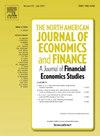An early prediction model on systemic risk under global risk: Using FinBERT and temporal fusion transformer to multimodal data fusion framework
IF 3.8
3区 经济学
Q1 BUSINESS, FINANCE
North American Journal of Economics and Finance
Pub Date : 2025-01-01
DOI:10.1016/j.najef.2025.102361
引用次数: 0
Abstract
Several United States banks went bankrupt in 2023, and the total scale exceeded the subprime 2008 mortgage crisis. Thus, determining how to better predict banks’ systemic risks is crucial. While past research used quantitative data and statistical methods, rarely incorporated qualitative data, and lacked research exploring the impact of public confidence on systemic risk.
This study examined 445,500 daily multimodal quantitative and qualitative data to analyze financial news. We obtained data on public confidence through finance bidirectional encoder representations from transformers (hereafter FinBERT) to explore the relationship between public confidence and systemic risk through temporal fusion transformers (TFTs). We established an early prediction model that predicts the next 5 and 20 days, achieving more accurate prediction performance than linear regression, LSTM (long short-term memory), and XGB (eXtreme gradient boosting).
Based on the model that uses the past 20 days to predict the next five days, we found that positive and negative public confidence had a greater impact on systemic risk. In comparison, neutral public confidence had a lesser effect. Macro data such as carbon dioxide emissions also impact systemic risk. By expanding the time range to 60 days to predict 20 days, we found that the most significant impact on systemic risk factors was month, negative public information, interest rate, quasi-leverage, and the GDP growth rate.
The findings indicate that public confidence deserves more attention than macro variables in preventing systemic risks in the banking industry. Negative public confidence significantly affects systemic risk, echoing the adage that Bad news has wings.
全局风险下的系统风险早期预测模型:基于FinBERT和时间融合转换器的多模态数据融合框架
2023年美国几家银行破产,总规模超过了2008年次贷危机。因此,决定如何更好地预测银行的系统性风险至关重要。而以往的研究多采用定量数据和统计方法,很少纳入定性数据,缺乏探讨公众信心对系统性风险影响的研究。本研究分析了445,500个每日多模式的定量和定性数据来分析财经新闻。我们通过金融双向编码器表示从变压器(以下简称FinBERT)获得公众信心数据,通过时间融合变压器(tft)探索公众信心与系统风险之间的关系。我们建立了一个预测未来5天和20天的早期预测模型,比线性回归、LSTM(长短期记忆)和XGB(极端梯度增强)的预测性能更准确。基于过去20天预测未来5天的模型,我们发现正面和负面的公众信心对系统性风险的影响更大。相比之下,中立的公众信心的影响较小。二氧化碳排放等宏观数据也会影响系统性风险。通过将时间范围扩大到60天来预测20天,我们发现对系统性风险因素影响最显著的是月份、负面公开信息、利率、准杠杆和GDP增长率。研究结果表明,在防范银行业系统性风险方面,公众信心比宏观变量更值得关注。负面的公众信心会显著影响系统风险,这与“坏消息有翅膀”这句谚语相呼应。
本文章由计算机程序翻译,如有差异,请以英文原文为准。
求助全文
约1分钟内获得全文
求助全文
来源期刊
CiteScore
7.30
自引率
8.30%
发文量
168
期刊介绍:
The focus of the North-American Journal of Economics and Finance is on the economics of integration of goods, services, financial markets, at both regional and global levels with the role of economic policy in that process playing an important role. Both theoretical and empirical papers are welcome. Empirical and policy-related papers that rely on data and the experiences of countries outside North America are also welcome. Papers should offer concrete lessons about the ongoing process of globalization, or policy implications about how governments, domestic or international institutions, can improve the coordination of their activities. Empirical analysis should be capable of replication. Authors of accepted papers will be encouraged to supply data and computer programs.

 求助内容:
求助内容: 应助结果提醒方式:
应助结果提醒方式:


